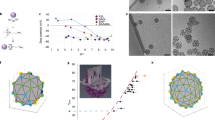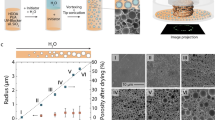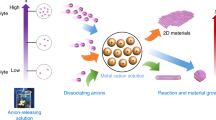Abstract
Ordered macroporous materials with pore diameters comparable to optical wavelengths are predicted to have unique and highly useful optical properties such as photonic bandgaps1,2,3 and optical stop-bands4. Tight control over the pore size distribution might also lead to improved macroporous materials (those with pores greater than approximately 50 nm) for application as catalytic surfaces and supports5, adsorbents, chromatographic materials, filters6, light-weight structural materials7, and thermal, acoustic8 and electrical insulators9. Although methods exist for producing ordered porous materials with pore diameters less than 10 nm (refs 10, 11), there is no general method for producing such materials with uniform pore sizes at larger length scales. Here we report a new method for producing highly monodisperse macroporous materials with pore sizes ranging from 50 nm to several micrometres. Starting with an emulsion of equally sized droplets (produced through a repeated fractionation procedure12), we form macroporous materials of titania, silica and zirconia by using the emulsion droplets as templates around which material is deposited through a sol–gel process13. Subsequent drying and heat treatment yields solid materials with spherical pores left behind by the emulsion droplets. These pores are highly ordered, reflecting the self-assembly of the original monodisperse emulsion droplets into a nearly crystalline array14. We show that the pore size can be accurately controlled, and that the technique should be applicable to a wide variety of metal oxides and even organic polymer gels.
This is a preview of subscription content, access via your institution
Access options
Subscribe to this journal
Receive 51 print issues and online access
$199.00 per year
only $3.90 per issue
Buy this article
- Purchase on Springer Link
- Instant access to full article PDF
Prices may be subject to local taxes which are calculated during checkout




Similar content being viewed by others
References
Yablonovitch, E. Photonic band-gap structures. J. Opt. Soc. Am. B 10, 283–295 (1993).
Joannopoulos, J. D., Meade, R. D. & Winn, J. N. Photonic Crystals: Molding the Flow of Light (Princeton Univ. Press, (1995)).
Soukoulis, C. Photonic Band Gap Materials (Kluwer, Dordrecht, (1996)).
Flaugh, P. L., O'Donnel, S. E. & Asher, S. A. Development of a new optical wavelength rejection filter: Demonstration of its utility in Raman spectroscopy. Appl. Spectrosc. 38, 847–850 (1984).
Harold, M. P. et al. Catalysis with inorganic membranes. MRS Bull. 19, 34–39 (1994).
Bhave, R. R. Inorganic membranes synthesis, characteristics, and applications (Van Nostrand Reinhold, New York, (1991)).
Wu, M. X., Fujiu, T. & Messing, G. L. Synthesis of cellular inorganic materials by foaming sol gels. J. Non-Cryst. Solids 121, 407–412 (1990).
Litovsky, E., Shapiro, M. & Shavit, A. Gas pressure and temperature dependences of thermal conductivity of porous ceramic materials. 2. Refractories and ceramics with porosity exceeding 30%. J. Am. Ceram. Soc. 79, 1366–1376 (1996).
Singer, P. Low k dielectrics: the search continues. Semicond. Int. 19, 88–96 (1996).
Beck, J. S. et al. Anew family of mesoporous molecular sieves prepared with liquid crystal templates. J. Am. Chem. Soc. 114, 10834–10843 (1992).
Krauss, T., Song, Y. P., Thoms, S., Wilkinson, C. D. W. & DelaRue, R. M. Fabrication of 2-D photonic bandgap stuctures in GaAs/AlGaAs. Electron. Lett. 30, 1444–1446 (1994).
Bibette, J. Depletion interactions and fractionated crystallization for polydisperse emulsion purification. J. Colloid. Interface Sci. 147, 474–478 (1991).
Brinker, C. J. & Scherer, G. W. Sol-Gel Science (Academic, San Diego, (1990)).
Pusey, P. N. & van Megen, W. Phase behaviour of concentrated suspensions of hard colloidal spheres. Nature 320, 340–342 (1986).
Walsh, D. & Mann, S. Fabrication of hollow porous shells of calcium carbonate from self-organizing media. Nature 377, 320–323 (1995).
Imhof, A. & Pine, D. J. Stability of nonaqueous emulsions. J. Colloid Interface Sci.(in the press).
Dinsmore, A. D., Yodh, A. G. & Pine, D. J. Entropic control of particle motion using passive surface microstructures. Nature 383, 239–242 (1996).
van Blaaderen, A., Ruel, R. & Wiltzius, P. Template-directed colloidal crystallization. Nature 385, 321–324 (1997).
Hachisu, S. & Yoshimura, S. Optical demonstration of crystalline superstructures in binary mixtures of latex globules. Nature 283, 188–189 (1980).
Bartlett, P., Ottewill, R. H. & Pusey, P. N. Superlattice formation in binary mixtures of hard-sphere colloids. Phys. Rev. Lett. 68, 3801–3804 (1992).
Sanchez, C., Babonneau, F., Doeuff, S. & Leaustic, A. in Ultrastructure Processing of Advanced Ceramics (eds Mackenzie, J. D. & Ulrich, D. R.) 77–87 (Wiley, New York, (1988)).
Acknowledgements
We thank F. Lange and G. Stucky for discussions, and Q. Huo for help with the adsorption measurements.
Author information
Authors and Affiliations
Corresponding author
Rights and permissions
About this article
Cite this article
Imhof, A., Pine, D. Ordered macroporous materials by emulsion templating. Nature 389, 948–951 (1997). https://doi.org/10.1038/40105
Received:
Accepted:
Issue Date:
DOI: https://doi.org/10.1038/40105
This article is cited by
-
Coarsely Granulated Macroporous Adsorbent for Adsorption Cleaning of Heavy Oil Stock
Chemistry and Technology of Fuels and Oils (2022)
-
3D monitoring of the surface slippage effect on micro-particle sedimentation by digital holographic microscopy
Scientific Reports (2021)
-
Synthesis and characterization of low-cost hierarchical porous silica by nanoemulsion templating: influence of nanoemulsion volume and hydrodynamic diameter
Journal of Sol-Gel Science and Technology (2021)
-
Colloidal diamond
Nature (2020)
-
Flat Wall Proximity Effect on Micro-Particle Sedimentation in Non-Newtonian Fluids
Scientific Reports (2020)
Comments
By submitting a comment you agree to abide by our Terms and Community Guidelines. If you find something abusive or that does not comply with our terms or guidelines please flag it as inappropriate.



